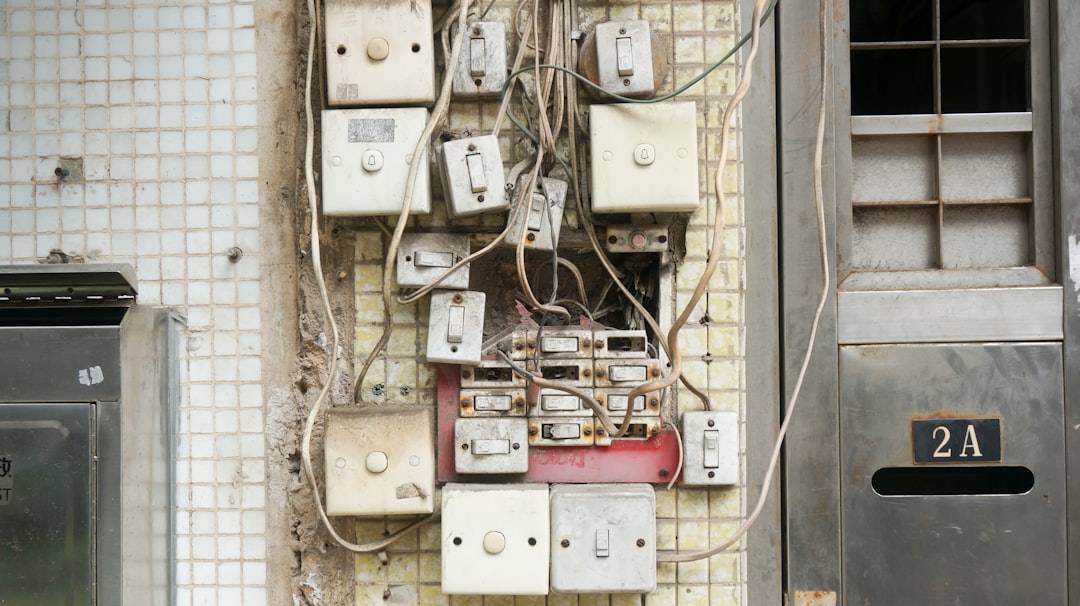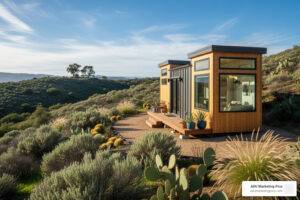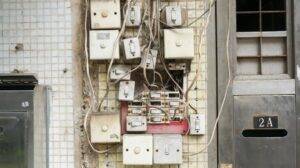Why Understanding ADU Electrical Requirements Matters in 2025
ADU electrical requirements are the set of codes, components, and safety standards needed to power an Accessory Dwelling Unit. As California’s ADU boom continues, navigating these rules is essential for a safe and legal project. Improper electrical work can cause fire hazards, fail inspections, and derail your budget.
With California’s 2025 Energy Code introducing stricter standards, understanding these requirements is more critical than ever. Here’s a quick overview of what’s involved:
Core ADU Electrical Requirements:
- Electrical Load Calculation: Determine the total amperage needed (typically 60-200 amps) for all appliances, lighting, and HVAC.
- Panel Configuration: Choose between a subpanel fed from the main house or a separate metered service.
- Code Compliance: Adhere to the National Electrical Code (NEC) and California’s Title 24 energy efficiency standards.
- Safety Devices: Install GFCI protection in wet areas (kitchens, baths) and AFCI protection in living spaces.
- Dedicated Circuits: Provide separate circuits for major appliances, bathrooms, and laundry.
- Solar Readiness: California requires new detached ADUs to have photovoltaic systems or be solar-ready.
- Professional Installation: All work must be done by a licensed electrician with proper permits and inspections.
This guide will break down these core elements, providing a clear roadmap for electrical planning that ensures your project is safe, compliant, and built to last.
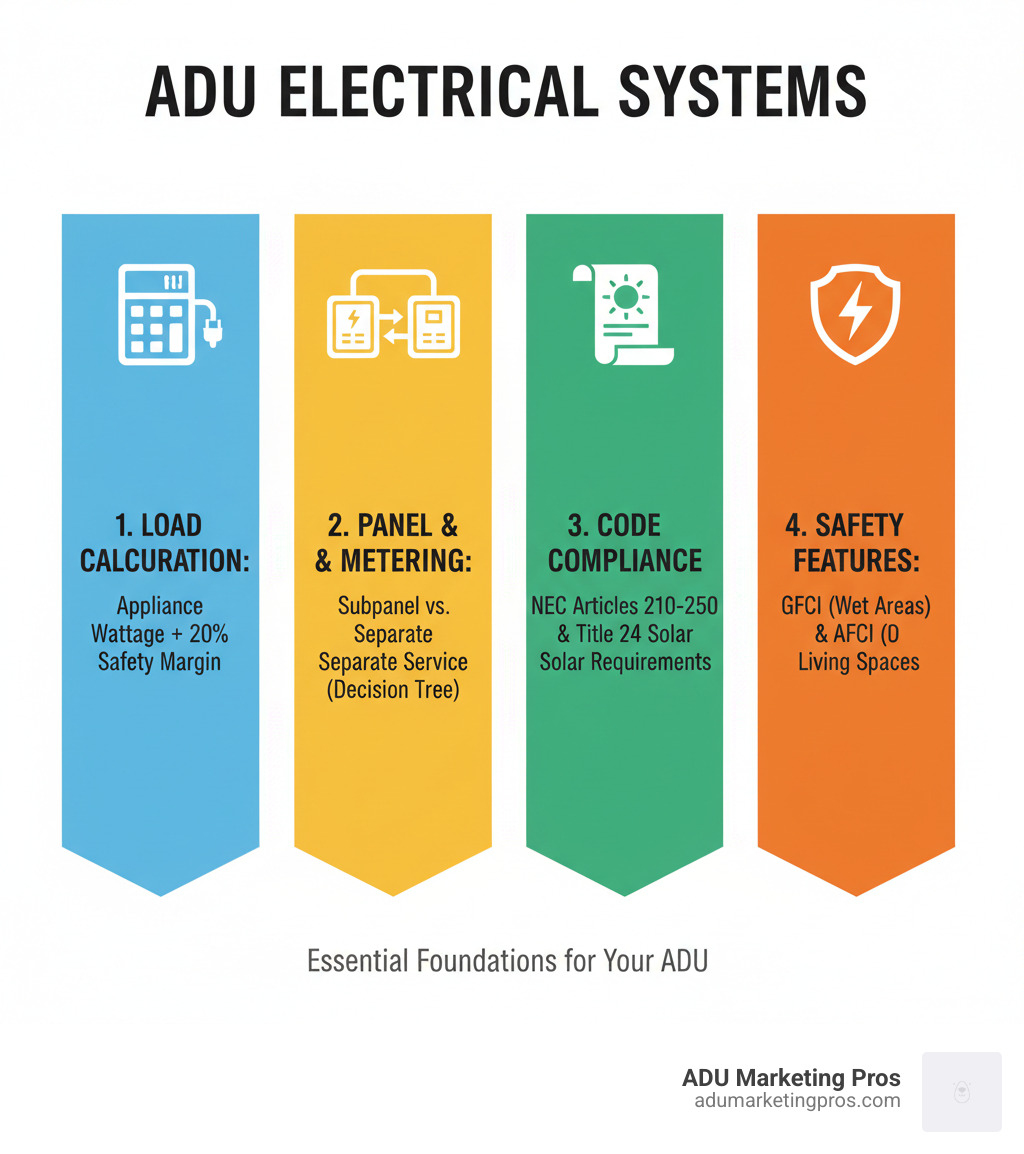
Core Electrical Foundations for Your ADU
This section covers the fundamental electrical components and calculations required to power your ADU safely and effectively. Understanding these basics is the first step toward a successful and compliant project.
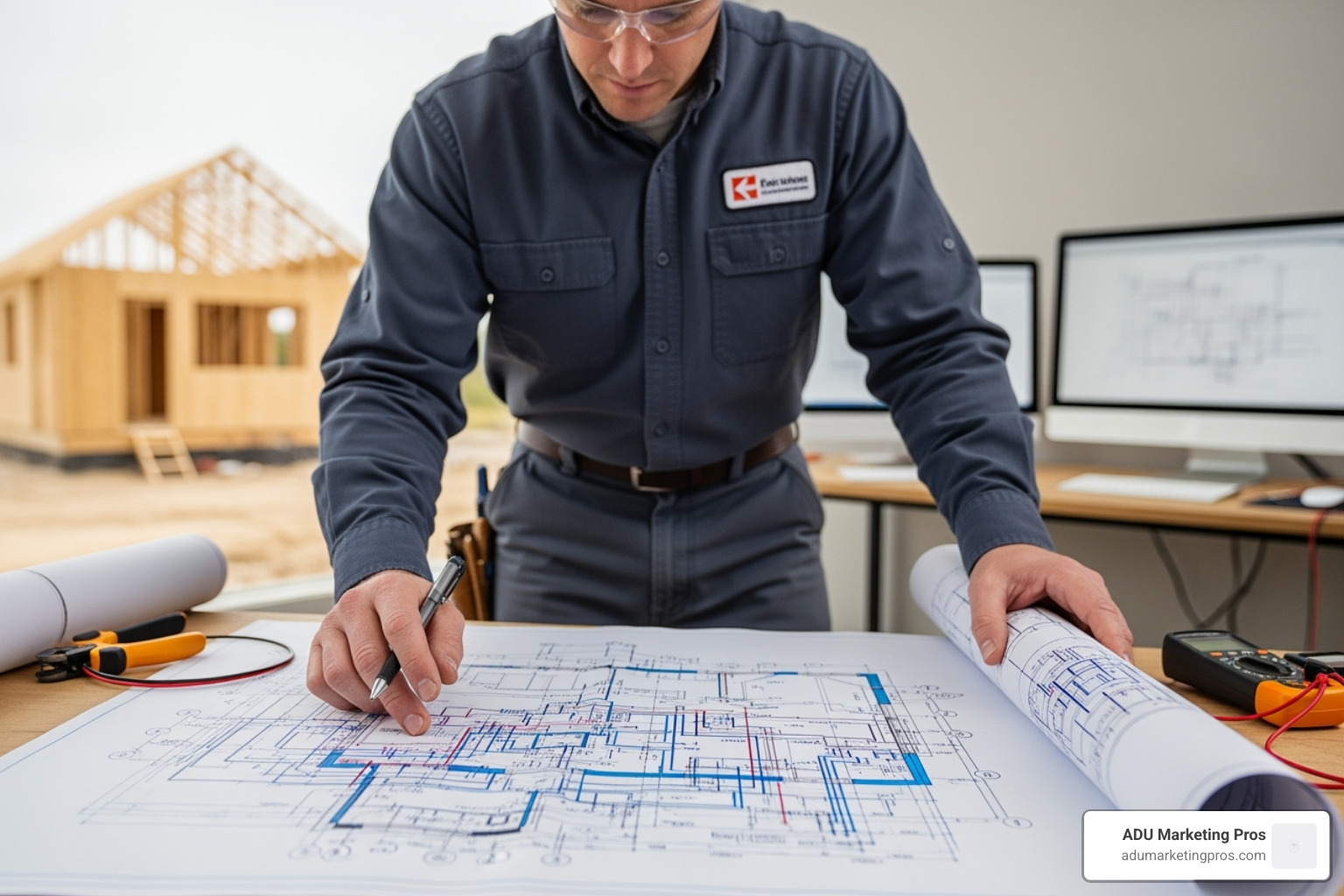
How to Calculate the Electrical Load for an ADU
An electrical load calculation is the process of determining the total amount of power your ADU will need to operate everything at once. Governed by NEC Article 220, this calculation is not a DIY task and must be performed by a licensed electrician. It accounts for every power-consuming component, including:
- Major Appliances: An electric range can demand 12,000 watts, while a refrigerator might use 700 watts. Each major appliance typically requires its own dedicated circuit.
- HVAC Systems: A central air conditioner or heat pump can be the single largest load, often requiring 3,000 to 5,000 watts.
- Future-Proofing: Planning for a future electric vehicle (EV) charger is critical. A Level 2 charger needs a dedicated 30 to 50-amp circuit, adding a significant load that is much cheaper to install during initial construction.
- General Loads: Lighting, outlets, and fans are calculated based on square footage and code requirements.
The final calculation determines the total amperage needed. Most ADUs require between 60 and 200 amps. A small unit with gas appliances might suffice with 60 amps, while a large, all-electric ADU with EV charging could need 200 amps or more. Electrical codes also mandate a safety margin (typically 20-25%) to prevent overloading and accommodate future needs. Getting this calculation right is the foundation of a safe and functional electrical system.
Choosing the Right Panel: Shared vs. Separate Systems
After determining your ADU’s power needs, you must decide how to supply it: with a subpanel connected to the main house or a completely separate electrical service. This choice impacts cost, complexity, and long-term use.
A subpanel is a secondary electrical panel in the ADU fed from the main house’s service panel. This is often the most affordable option if your main service panel (MSP) has enough spare capacity. A licensed electrician must perform a load calculation on the entire property to confirm this. If the existing service is insufficient (common in older homes with 100-amp panels), an MSP upgrade will be necessary, adding to the project cost.
The alternative is a separate electrical panel with its own separate meter. This creates an independent electrical service for the ADU, with its own utility bill. While the upfront cost is higher due to new service lines and meter installation, it’s the preferred choice for rental units. It provides clear and simple utility billing, eliminating disputes over shared costs.
Local utility rules from providers like LADWP in Los Angeles or SDG&E in San Diego will influence this decision. For example, LADWP may require all meters to be grouped together, while SDG&E often recommends the main home have at least 225 amps of service to support an ADU. Regardless of the choice, a standard ADU typically requires its own panel with at least 100 amps of capacity.
| Feature | Shared Panel (Subpanel) | Separate Meter (New Service) |
|---|---|---|
| Cost | Lower initial cost (if main panel has capacity) | Higher initial cost (new service line, meter, panel) |
| Billing | Integrated with main house (requires sub-metering for tracking) | Independent utility billing |
| Future Flexibility | Limited by main panel capacity; potential future upgrades | More capacity for future expansion (e.g., EV charging) |
| Installation Complexity | Less complex, fewer utility company interactions | More complex, significant coordination with utility company |
| Best For | Owner-occupied ADUs, smaller loads, budget-conscious | Rental ADUs, larger loads, complete independence, long-term planning |
Navigating Key Compliance and Safety Mandates
Meeting code isn’t just about passing an inspection; it’s about ensuring the long-term safety of your property and its occupants. This section breaks down the essential safety devices and regulatory bodies governing your ADU’s electrical work.
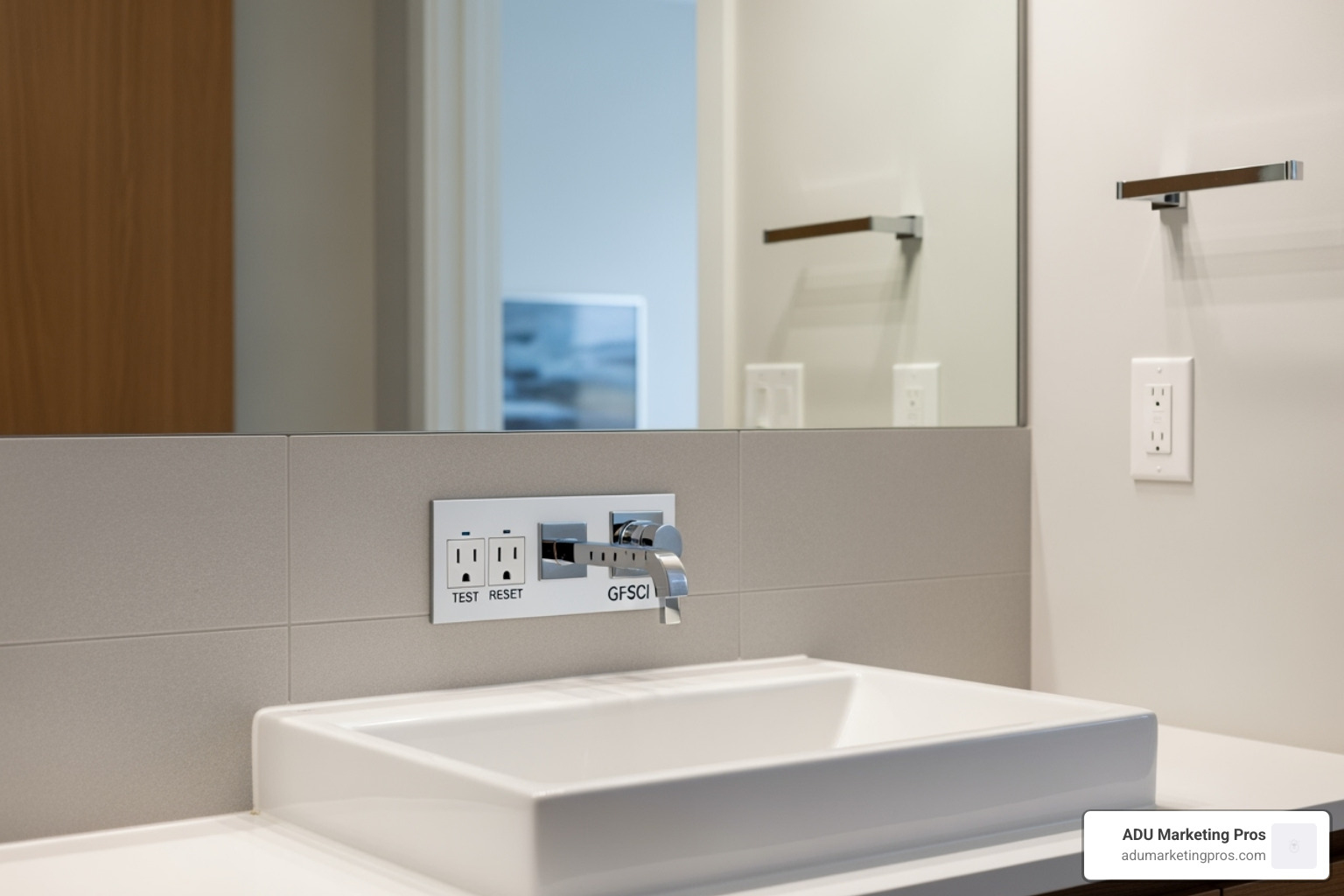
Understanding Your ADU Electrical Requirements for GFCI and AFCI Protection
When planning your ADU electrical requirements, two non-negotiable safety devices are Ground Fault Circuit Interrupters (GFCIs) and Arc Fault Circuit Interrupters (AFCIs). They are mandated by code to prevent electrocution and fires.
GFCI Protection (Shock Prevention)
A GFCI monitors electrical current and instantly cuts power if it detects a leak, such as current flowing through water or a person. This rapid response prevents deadly shocks. Per the NEC, Ground Fault Circuit Interrupters are required in all locations where electricity and water may meet. For your ADU, this includes:
- Bathrooms (all receptacles)
- Kitchens (countertop outlets and any near a sink)
- Garages and unfinished basements
- Outdoor areas and crawl spaces
- Laundry areas
AFCI Protection (Fire Prevention)
An AFCI detects dangerous electrical arcs—sparks from damaged wiring or loose connections that can ignite surrounding materials. Unlike harmless arcs from flipping a switch, these dangerous arcs trigger the AFCI to trip the circuit, preventing a fire. As detailed by resources like the National Association of Certified Home Inspectors on Arc Fault Circuit Interrupters, AFCI protection is required for 120-volt, 15- and 20-amp circuits in nearly all living spaces, including:
- Bedrooms
- Living rooms and family rooms
- Hallways and closets
- Kitchens and laundry areas (often requiring dual GFCI/AFCI protection)
The Role of Permits and Inspections in ADU Electrical Work
Permits and inspections are not obstacles; they are safety checkpoints that protect your investment and the people who will live in the ADU. All electrical work in an ADU requires a permit, which is typically handled by your licensed electrician as part of the overall building permit.
The process involves several key stages:
- Plan Check: Your electrician submits detailed plans and load calculations to the city. Once approved, a permit is issued.
- Rough-In Inspection: An inspector examines all wiring, boxes, and conduits after installation but before the walls are closed up. This is a critical step to catch any issues early.
- Final Inspection: After all fixtures are installed and the system is operational, a final inspection confirms that all safety devices work, panels are labeled, and the installation is fully code-compliant.
Attempting to bypass this process with unpermitted work is a major risk. It can lead to fines, orders to tear out finished walls for inspection, and denial of insurance claims. A licensed electrician ensures your project meets all ADU electrical requirements, passes inspections, and is completed safely and correctly the first time.
California-Specific ADU Electrical Requirements (Title 24 & Solar)
California leads the nation in energy efficiency standards, and ADUs are no exception. Title 24 and the state’s solar mandate introduce specific requirements that every homeowner must know before breaking ground.
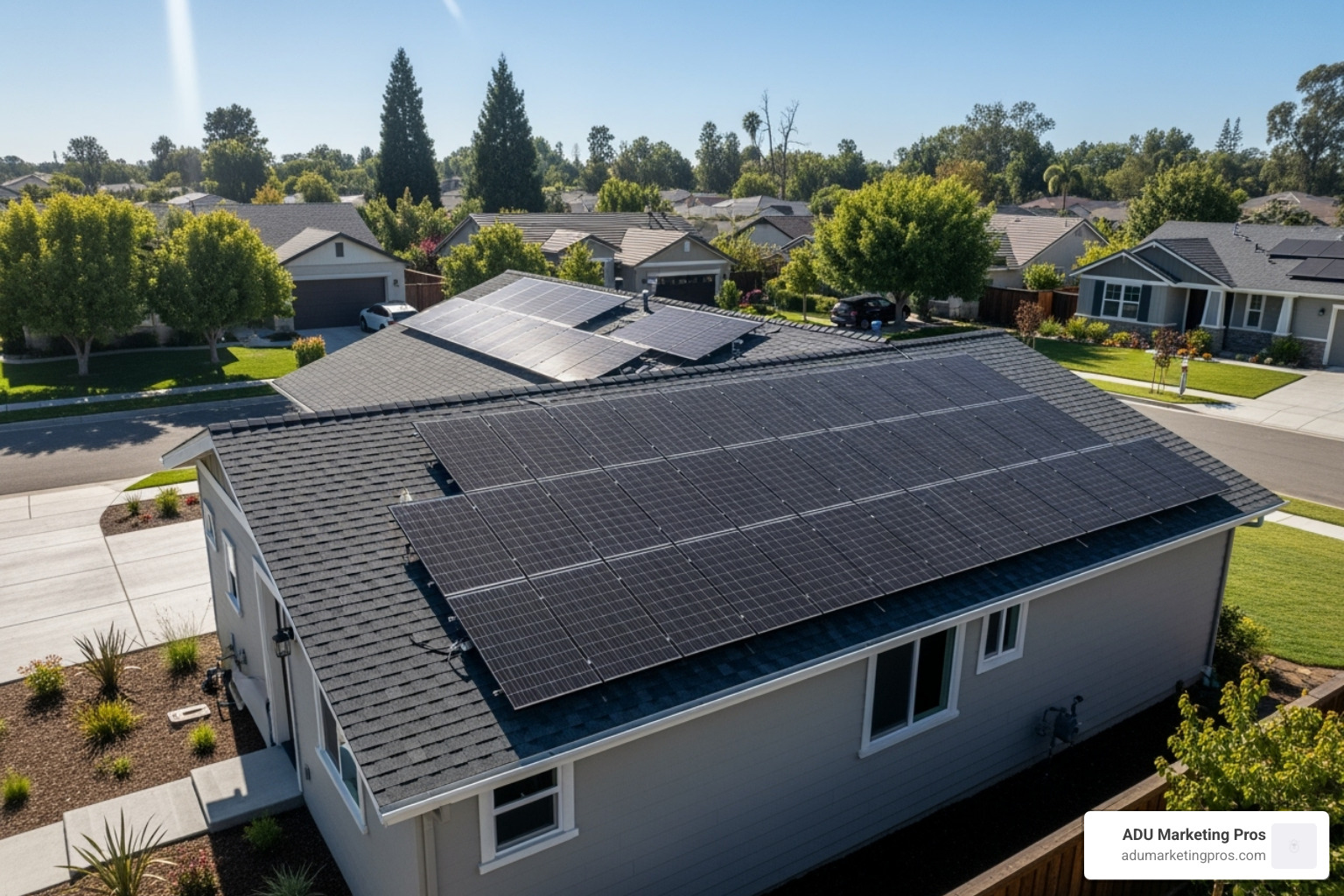
Decoding the Title 24 Solar Mandate for ADUs
California’s Title 24 Energy Code is the state’s blueprint for energy efficiency in construction, and it heavily influences ADU electrical requirements. Compliance is mandatory and involves several key components:
- High-Efficacy Lighting: All lighting must be high-efficacy, which generally means using LED fixtures throughout the unit.
- Vacancy Sensors: Bathrooms, laundry rooms, and utility closets must have sensors that automatically turn off lights when the room is unoccupied.
- Dimming Controls: All habitable spaces require dimmers to allow occupants to adjust lighting levels and save energy.
The most significant part of Title 24 for ADUs is the solar mandate. All newly constructed, detached ADUs must be equipped with a photovoltaic (PV) system (solar panels). The size of the system is determined by a formula based on the ADU’s conditioned floor area.
However, there are exemptions. Garage conversions and ADUs attached to the main house are typically exempt from the solar installation mandate. Projects with limited roof space or significant shading may also qualify for an exception. Even if exempt from installing panels, many projects must be “solar-ready,” meaning the conduit and electrical infrastructure for a future solar installation must be put in place during construction.
The 2025 Title 24 updates also introduce “solar battery-ready” provisions, requiring specific infrastructure for future energy storage systems. This includes dedicated breakers, conduits, and panel space for a transfer switch and emergency subpanel. This forward-thinking requirement ensures ADUs are prepared for the future of energy storage. All work must comply with the California Electrical Code standards, which incorporate national codes with state-specific amendments.
Leveraging Solar Incentives in California
While the solar mandate adds an upfront cost, federal and state incentives can significantly reduce the financial impact. Smart homeowners leverage these programs to make solar a financially attractive investment.
-
Federal Solar Investment Tax Credit (ITC): This is the most powerful incentive. It allows you to claim a 30% federal tax credit on the total cost of your solar system. A $15,000 system, for example, would yield a $4,500 credit, directly reducing your tax liability.
-
Net Energy Metering (NEM): Offered by utilities like SDG&E and PG&E, NEM programs credit you for excess electricity your solar panels send back to the grid. These credits can offset your electricity costs, often reducing or even eliminating your monthly bill.
-
Local and State Programs: Programs like the San Diego Solar Equity Program can provide additional financial assistance for low-income households. The California Solar Initiative (CSI) and its successor programs have also historically offered rebates.
These incentives not only make solar more affordable but also increase your property value and make rental units more attractive with the promise of lower utility bills. By combining these financial benefits with environmental responsibility, California’s solar mandate becomes a win-win for ADU owners.
Planning Your ADU Electrical Project: From Blueprint to Power-On
A successful electrical installation hinges on meticulous planning and professional execution. The difference between a smooth project and a costly nightmare often comes down to how well you prepare in the early stages. Let’s walk through the essential steps to ensure your ADU’s electrical system runs smoothly, stays on budget, and meets all regulatory requirements.
Key steps in planning your ADU electrical requirements
Properly planning your ADU’s electrical system is a critical process that requires professional expertise. Follow these key steps to build a safe and robust foundation:
- Assess Total Power Needs: Work with an electrician to create a comprehensive list of all appliances and systems (HVAC, water heater, EV charger, etc.) to perform an accurate load calculation.
- Follow NEC Circuit Minimums: The National Electrical Code (NEC) requires dedicated circuits for the kitchen (two small appliance circuits), laundry, and bathroom. It also specifies rules for outlet placement in all rooms.
- Determine Panel Type and Size: Based on the load calculation, decide between a subpanel or a separate metered service. Most ADUs need a 100- to 200-amp panel, and it’s wise to choose one with extra space for future needs.
- Coordinate with Your Utility Company Early: Contact your local provider (SDG&E, PG&E, LADWP) at the beginning of your project. The process for service upgrades or new connections can take months.
- Plan for Solar Integration: As required by Title 24, plan your roof layout and electrical infrastructure for solar panels, even if you are exempt from immediate installation.
- Future-Proof Your Installation: Consider adding infrastructure for future technologies now. Running conduit for an EV charger or pre-wiring for smart home devices during construction is far cheaper than retrofitting later.
- Hire a Qualified Contractor: Never cut corners on electrical work. Hire a licensed electrician with specific experience in local ADU electrical requirements. Their expertise is essential for safety, code compliance, and avoiding costly mistakes.
JADU vs. ADU: What are the electrical differences?
While both Junior Accessory Dwelling Units (JADUs) and standard Accessory Dwelling Units (ADUs) provide housing, their electrical requirements differ significantly, primarily due to size and integration.
A JADU is limited to 500 square feet and must be created within the existing footprint of the main house. An ADU can be larger (up to 1,200 sq. ft. or more) and can be attached, detached, or a conversion.
The key electrical distinctions are:
- Power Source: A JADU is legally required to share its electrical service with the primary dwelling. It cannot have a separate meter. An ADU can have its own subpanel or a completely separate metered service.
- Load Calculation: Because a JADU’s load is added to the main house’s service, the calculation is simpler. An ADU’s larger load often necessitates a main service panel upgrade or a new service.
- Circuit Requirements: A JADU has a small “efficiency kitchen,” requiring fewer dedicated circuits than a full ADU kitchen. However, all GFCI and AFCI safety requirements still apply.
- Solar Mandate: JADUs are treated as part of the main home for solar purposes and are not subject to the separate solar mandate that applies to new, detached ADUs.
In short, a JADU’s electrical system is an extension of the main house, making it simpler and less expensive but also less independent. An ADU offers complete electrical independence, which is ideal for rental units.
Frequently Asked Questions about ADU Electrical Requirements
Does my ADU need its own electrical panel?
Yes, virtually every ADU requires its own electrical panel to safely manage its power needs. However, this doesn’t necessarily mean it needs a separate utility meter.
- Subpanel (Most Common): Most ADUs use a subpanel, which is fed from the main house’s primary electrical panel. This is a cost-effective way to provide dedicated circuits and breakers for the ADU.
- Separate Metered Service: You can opt for a completely separate service with its own meter. This is more expensive upfront but is highly recommended for rental ADUs because it allows for independent utility billing.
The decision depends on the ADU’s electrical load, your budget, and whether you plan to rent the unit. A licensed electrician can determine the best and most compliant solution for your project.
How much does an electrical upgrade for an ADU cost?
The cost of electrical work for an ADU varies widely, from a few thousand dollars to over $15,000, depending on the project’s scope. Key factors influencing the cost include:
- Panel Upgrades: If your main house panel lacks the capacity to support the ADU, an upgrade can cost between $2,000 and $5,000.
- Trenching: Running underground power lines to a detached ADU is a major expense, often ranging from $5,000 to $10,000 or more depending on distance and terrain.
- New Service/Meter: Establishing a completely new, separately metered service involves significant coordination with the utility company and can add several thousand dollars to the cost.
- Location: Labor and material costs differ significantly across California, from San Diego to the San Francisco Bay Area.
Because of these variables, it is essential to get detailed quotes from licensed electricians based on a site assessment and your specific plans.
What are the main electrical differences for an ADU in Los Angeles vs. San Diego?
While state-level regulations like the NEC and Title 24 apply everywhere in California, local jurisdictions and utility companies have their own specific rules. This is why ADU electrical requirements can differ between major cities.
-
Los Angeles (LADWP):
- Meter Grouping: The Los Angeles Department of Water and Power (LADWP) generally requires all electrical meters for a property to be grouped in a single location on the primary residence.
- Separate Addresses: If an ADU is given a separate meter, it must also have its own unique legal address.
-
San Diego (SDG&E):
- Service Capacity: It is a common recommendation in San Diego County that the main home’s electrical service have at least 225 amps of capacity to support an ADU, often prompting a service upgrade.
- Utility Coordination: The process for getting a new service connection from SDG&E is distinct and can take several months to complete.
These examples highlight why working with a contractor who has local expertise is crucial. Navigating the specific rules of your city and utility provider is key to a smooth project.
Conclusion
Navigating ADU electrical requirements is a critical step in any successful ADU project. From performing an accurate load calculation and choosing the right panel to complying with California’s Title 24 energy code and solar mandates, every decision impacts the safety, efficiency, and legality of your new unit.
By understanding the roles of GFCI/AFCI protection, permits, and inspections, you can ensure your project is built to last. Leveraging solar incentives can also turn a regulatory requirement into a smart financial investment. Investing in a robust, code-compliant electrical system is about future-proofing your property and maximizing its value, whether for family, rental income, or personal use.
For ADU construction and architecture firms, mastering these complexities is what sets you apart. At ADU Marketing Pros, based in San Jose, CA, we help firms like yours showcase this expertise to attract high-value clients. We understand the nuances of the ADU market across California and can help you communicate your authority effectively.
Ready to dig deeper into other aspects of ADU construction? Learn how to navigate the complexities of your project, from electrical to finishing touches, in our complete guide to ADU garage conversions.

